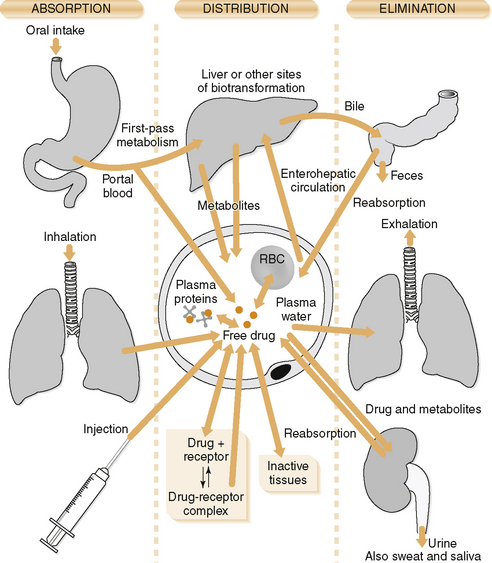Medications are a cornerstone of modern healthcare, helping millions of people manage their health conditions, alleviate symptoms, and even save lives. But have you ever wondered how these drugs work once they enter your body? The answer lies in the intricate world of drug metabolism and pharmacokinetics – two crucial fields that govern how drugs are processed, distributed, and eliminated within your body. In this blog post, we will embark on a fascinating journey through the science behind medication action, shedding light on the complex processes that occur behind the scenes. So, let’s dive in and unravel the mysteries of drug metabolism and pharmacokinetics.
The Basics of Drug Metabolism
Metabolism: The Body’s Chemical Factory
Before we delve into drug metabolism, it’s essential to understand the concept of metabolism itself. Metabolism is a complex network of chemical reactions that occur within your body’s cells to maintain life. It involves processes such as converting food into energy, eliminating waste products, and synthesizing essential molecules.
In the context of drug metabolism, we are specifically concerned with how your body processes and transforms medications. When you ingest a medication, your body sees it as a foreign substance, and it initiates a series of reactions to break down and eliminate the drug from your system.
Phase I Metabolism: Transforming Drugs
The first phase of drug metabolism involves transforming the drug into a more water-soluble form. This makes it easier for the body to eliminate the drug through urine or feces. Phase I metabolism primarily occurs in the liver and involves enzymes known as cytochrome P450 (CYP) enzymes.
CYP enzymes catalyze various chemical reactions, such as oxidation, reduction, and hydrolysis, to modify the drug’s structure. This modification can lead to one of three outcomes:
Activation: In some cases, Phase I metabolism can convert an inactive prodrug into its active form, allowing it to exert its therapeutic effects. Prodrugs are medications that require activation within the body.
Inactivation: Conversely, Phase I metabolism can also render an active drug inactive, making it less effective or easier to eliminate.
No Change: In some instances, Phase I metabolism may have no significant effect on the drug’s activity.
Phase II Metabolism: Making Drugs Water-Soluble
Once the drug has undergone Phase I metabolism, it often becomes more chemically reactive. To make it less toxic and easier to eliminate, your body proceeds to Phase II metabolism. In this phase, the drug is conjugated, or chemically combined, with another molecule, usually a polar compound like glucuronic acid, sulfate, or amino acids.
Conjugation makes the drug more water-soluble and less likely to be reabsorbed by the body, facilitating its elimination through urine or feces. Phase II metabolism occurs in various tissues, including the liver, kidneys, and intestines.
The Role of Enzymes
Enzymes play a pivotal role in drug metabolism. Enzymes are specialized proteins that catalyze chemical reactions, and they are responsible for the transformation of drugs during Phase I and Phase II metabolism.
Cytochrome P450 enzymes, as mentioned earlier, are crucial in Phase I metabolism. They are responsible for oxidizing drugs and are highly variable among individuals, contributing to variations in drug response.
Phase II enzymes, on the other hand, include a range of enzymes like UDP-glucuronosyltransferases (UGTs), sulfotransferases (SULTs), and glutathione S-transferases (GSTs). These enzymes facilitate the conjugation of drugs with other molecules, rendering them less active and more water-soluble.
Factors Influencing Drug Metabolism
Several factors can influence drug metabolism, leading to variations in how individuals respond to medications. These factors include:
Genetics: Genetic variations can affect the activity of enzymes involved in drug metabolism, leading to differences in drug efficacy and safety among individuals.
Age: Metabolic processes may change with age, affecting how drugs are metabolized, especially in the very young and the elderly.
Diet and Lifestyle: Diet, alcohol consumption, and smoking can impact the activity of drug-metabolizing enzymes.
Other Medications: Some drugs can inhibit or induce the activity of drug-metabolizing enzymes, potentially affecting the metabolism of other medications taken concurrently.
Pharmacokinetics: The Journey of a Drug in Your Body
Pharmacokinetics is the study of how the body processes a drug after it is administered. It involves four key processes: absorption, distribution, metabolism, and elimination, often abbreviated as ADME. Let’s explore each of these processes in detail:
1. Absorption: This is the process by which a drug enters your bloodstream from its site of administration, which can be oral (through the mouth), intravenous (through a vein), transdermal (through the skin), or other routes. Factors like the drug’s formulation, route of administration, and the presence of food can influence absorption.
2. Distribution: Once in the bloodstream, the drug is carried to various tissues and organs throughout the body. Distribution can be influenced by factors such as blood flow, tissue binding, and the drug’s chemical properties.
3. Metabolism: As discussed earlier, metabolism involves the transformation of the drug’s chemical structure, primarily in the liver. Metabolism can either activate or inactivate the drug and prepares it for elimination.
4. Elimination: This is the final step where the drug and its metabolites are removed from the body. The primary organs responsible for drug elimination are the kidneys (through urine) and the liver (through bile and feces).
Pharmacokinetic Parameters
Pharmacokinetics uses various parameters to describe a drug’s behavior within the body:
Bioavailability: This measures the fraction of the drug that reaches the bloodstream unchanged after administration. For example, intravenous administration has 100% bioavailability because the drug is directly injected into the bloodstream.
Half-life: This is the time it takes for half of the drug to be eliminated from the body. It helps determine the dosing frequency of a medication.
Clearance: Clearance is the rate at which the drug is removed from the bloodstream, typically measured in volume per time (e.g., liters per hour).
Volume of Distribution (Vd): Vd represents the apparent volume into which a drug is distributed in the body. It helps in understanding how extensively a drug distributes beyond the bloodstream.
Clinical Implications of Drug Metabolism and Pharmacokinetics
Understanding drug metabolism and pharmacokinetics is vital for healthcare professionals and patients alike. It allows for:
Optimized Dosing: Knowledge of a drug’s pharmacokinetics helps determine the appropriate dosage to achieve the desired therapeutic effect while minimizing side effects.
Personalized Medicine: Genetic factors influencing drug metabolism can guide the selection of medications and dosages tailored to an individual’s genetic makeup.
Drug Interaction Management: Awareness of potential drug interactions can help prevent adverse effects when multiple medications are used concurrently.
Monitoring and Safety: Regular monitoring of drug levels in the blood can ensure that therapeutic concentrations are maintained, optimizing treatment outcomes and patient safety.
In Conclusion: A Symphony of Complexity
Drug metabolism and pharmacokinetics are intricate processes that orchestrate the fate of medications within the human body. Understanding how drugs are absorbed, distributed, metabolized, and eliminated is essential for the safe and effective use of medications in healthcare. As science continues to advance, so too will our understanding of these processes, paving the way for more personalized and effective treatments in the future.
References:
https://www.msdmanuals.com/professional/clinical-pharmacology/pharmacokinetics/drug-metabolism
https://www.pharmacologyeducation.org/pharmacology/drug-metabolism







